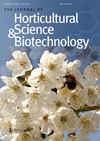‘Norton’、‘Vignoles’和‘St.’初生芽抗寒性的驯化与脱驯化。文森特的葡萄园
IF 2.1
4区 农林科学
Q2 HORTICULTURE
Journal of Horticultural Science & Biotechnology
Pub Date : 2001-01-01
DOI:10.1080/14620316.2001.11511426
引用次数: 5
摘要
“诺顿”、“维格诺尔”和“圣”初生芽抗寒性的驯化与脱驯化。文森特的葡萄藤在美国密苏里州格罗夫山的西南密苏里州立大学研究校园进行了研究。1997年1月和2月,在-10°C条件下驯化7 d,然后在20°C条件下脱驯化1、2、3、5和7 d。1997 ~ 1998年冬季,12月、2月和3月分别在-7℃和20℃条件下进行1、2、3、5和7 d的驯化。同时对田间温度条件下初芽的抗寒性进行了评价。初芽的抗寒性受温度制度、驯化和脱驯化时间长短的影响。“诺顿”是最耐寒的品种,“圣文森特”是最不耐寒的品种,而“维格诺尔”对适应和反适应温度最不敏感。从12月到3月,初芽的抗寒性逐渐降低,对驯化温度和脱驯化温度的敏感性逐渐增加。暴露于-7或-10°C增加耐寒性,暴露于20°C在某些采样期间降低耐寒性,但并非总是如此。似乎有一个抗寒性的最高水平,超过这个水平,初芽将不适应;有一个抗寒性的最低水平,低于这个水平,初芽将不适应。本文章由计算机程序翻译,如有差异,请以英文原文为准。
Acclimation and deacclimation of primary bud cold hardiness in ‘Norton’, ‘Vignoles’ and ‘St. Vincent’ grapevines
Summary Acclimation and deacclimation of primary bud cold hardiness in ‘Norton’, ‘Vignoles’, and ‘St. Vincent’ grapevines were studied at Southwest Missouri State University Research Campus in Mountain Grove, Missouri, USA. Canes from mature vines were acclimated at -10°C for 7 d and then subjected to deacclimation at 20°C for 1,2,3,5 and 7 d in January and February 1997.During 1997-98 winter season, they were acclimated at -7°C and deacclimated at 20°C for 1, 2, 3, 5, and 7 d in December, February, and March. Cold hardiness of primary buds under field temperature conditions was also evaluated at the same time as the buds treated under laboratory conditions. Cold hardiness of primary buds was influenced by temperature regimes, and the length of exposure time to acclimating and deacclimating temperatures. ‘Norton’ was the most cold hardy and ‘St Vincent’ was the least cold hardy cultivar, while ‘Vignoles’ was least sensitive to acclimating and deacclimating temperatures. Cold hardiness of primary buds decreased gradually while their sensitivity to acclimating and deacclimating temperatures increased, from December to March. Exposure to -7 or -10°C increased cold hardiness and exposure to 20°C decreased cold hardiness during certain sampling periods but not always so. It seems that there is a maximum level of cold hardiness above which primary buds will not acclimate and there is a minimum level of cold hardiness below which primary buds will not deacclimate.
求助全文
通过发布文献求助,成功后即可免费获取论文全文。
去求助
来源期刊
CiteScore
3.90
自引率
5.30%
发文量
67
审稿时长
3 months
期刊介绍:
The Journal of Horticultural Science and Biotechnology is an international, peer-reviewed journal, which publishes original research contributions into the production, improvement and utilisation of horticultural crops. It aims to provide scientific knowledge of interest to those engaged in scientific research and the practice of horticulture. The scope of the journal includes studies on fruit and other perennial crops, vegetables and ornamentals grown in temperate or tropical regions and their use in commercial, amenity or urban horticulture. Papers, including reviews, that give new insights into plant and crop growth, yield, quality and response to the environment, are welcome, including those arising from technological innovation and developments in crop genome sequencing and other biotechnological advances.

 求助内容:
求助内容: 应助结果提醒方式:
应助结果提醒方式:


